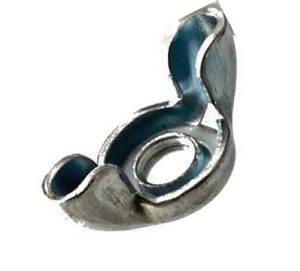
Wing nuts offer a quick and easy way to fasten parts. Also known as butterfly nuts, they feature a pair of tabs on the side. The tabs are essentially “wings,” hence the name “wing nuts.” You can use these tabs to install and remove wing nuts on threaded fasteners.
Traditional threaded fasteners typically require a wrench or screwdriver with the appropriate drive type (e.g. Philips head). Wing nuts eliminate the need for a special tool. You can install and remove them by twisting the tabs on the side. All wing nuts feature tabs on the side, but they are available in four primary types.
Type A
Type A wing nuts are characterized by a cold-forged construction. They are shaped below their the recrystallization point of the metal from which they are made. Examples of cold forging include pressing, drawing and rolling. The American Society of Mechanical Engineers (ASME) defines Type A wing nuts as being cold forged in regular, light and heavy series.
Type B
Type B wing nuts are characterized by a hot-forged construction. Hot forging is the opposite of cold forging. While cold forging involves shaping a metal workpiece below its recrystallization point, hot forging involves shaping a metal workpiece above its recrystallization point. The metal workpiece is exposed to hot temperatures. As it’s heated, the metal workpiece becomes more malleable. It can then be shaped and manipulated into a different shape.
Type C
There are also Type C wing nuts. Type C wing nuts are made via die casting. Die casting is a molding process in which molten material, such as steel, is poured into the cavity of a mold. The molten material will fill the space inside of the mold cavity. After the molten material has cooled, it will leave behind a solid object in the shape of the mold cavity. This object or “casting” is ejected from the mold cavity, at which point it can be sold or further processed.
Type C wing nuts are made via die casting. According to the ASME, they are also available in regular and heavy series.
Type D
Finally, there are Type D wing nuts. Type D wing nuts feature the same two-prong design as their Type A, Type B and Type C counterparts. The difference is that Type D wing nuts are made of stamped sheet metal.
Metal stamping is a manufacturing process that involves the use of a stamping press. Flat sheet metal is placed into the stamping press where it’s shaped. Only Type D wing nuts are made using a stamping press.
In Conclusion
You can’t ignore the Type when shopping for wing nuts. The ASME recognizes four Types of wing nuts. Type A wing nuts are made via cold forging. Type B wing nuts are made via hot forging. Type C wing nuts are made via die casting. And Type D wing nuts are made via stamping.
